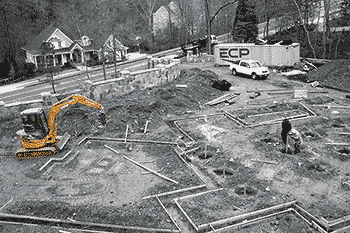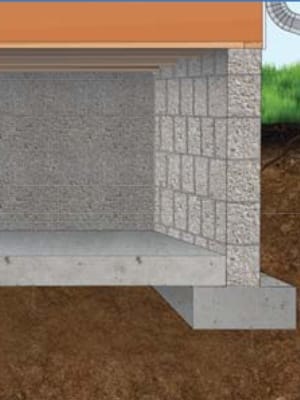Different Types of Home Foundations

Though most home foundations are made of concrete, there are a few key differences in the many variations. Some factors that affect what type of foundation you should choose for your home include the soil type in the area, the climate, and the size and design of your home. Some soils require a home to have a very deep-rooted foundation, while other soils are better at supporting the structure. Also, some types of foundations are not able to withstand cold weather or flood conditions as well as other types. Choose the right foundation to avoid foundation problems such as a sinking or settling foundation, or slab cracks.
Types of Home Foundations
The most common type of home foundation is a poured concrete foundation. There are many types of concrete foundations, including the slab foundation and the basement foundation. In a slab foundation, a concrete slab that makes the foundation is poured onto a bed of crushed gravel. This improves drainage and makes the foundation ideal for areas where the ground does not freeze in the wintertime. A basement foundation is a bit different. This concrete foundation rests in a hole in the ground and is supported by concrete footings, which are poured pads that serve as a base for the walls. These footings are both wider and longer than the walls and work much like feet in distributing the weight of the wall and the above structure. They are often used in places that have cold winters.
The next type of home foundation is the crawl space. This space is located between the bottom of your home and the soil and is usually just tall enough for you to crawl into. This type of foundation is great for areas with lots of clay in the soil. They are also one of the most affordable types of foundation. A crawl space does, however, need to be encapsulated to prevent water damage from occurring.
Home Foundation Options for Every Situation

For use in areas where the winters are very cold, a frost-protected foundation is a suitable choice. These foundations are usually T-shaped and the footings extend deep below the frost line to provide extra support for the slab. Frost-protected foundations can, however, be installed without digging below the frost line. These are called frost-protected shallow foundations (FPSF) and use insulated concrete to protect the foundation from the cold.
In areas that are prone to flooding, a raised foundation is best. There are two types of raised foundations: pier-and-beam and stem wall. Both require lots of care and planning, as they must protect against water as well as support the weight of the structure. A pier-and-beam foundation works by using concrete or brick blocks reinforced with footings. These blocks are placed about 8-12 inches apart to raise the home above the flood line. Stem wall foundations are similar, but instead of having spaced footings, they have continuous footings.
Permanent wood foundations are another type of foundation. They are recommended by many manufacturers as an alternative to crawl space, basement, and stem wall foundations. This type of foundation is made of lightweight, preservative-treated, decay-resistant wood. Because they do not require concrete pouring or casting, permanent wood foundations are convenient and easy to install. They are also moisture-resistant and easier to insulate than other types of home foundations.
To decide what type of foundation is best for you and your home, talk to a professional structural engineer. My Foundation Repair can connect you with some of the best in the business. Let us help you out today!
